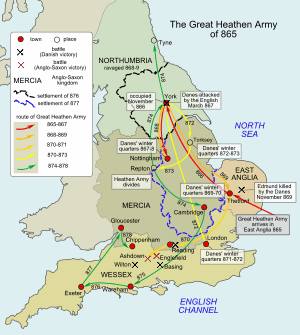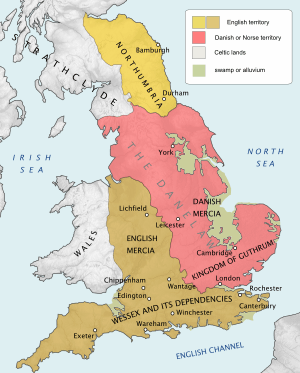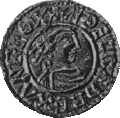Great Heathen Army facts for kids
The Great Heathen Army, also known as the Great Danish Army or The Great Viking Army, was a huge group of Vikings from Denmark. They came to attack Anglo-Saxon England. This large army first arrived in East Anglia in the year 865. Unlike earlier Vikings who just made quick attacks and left, the Great Army stayed for many years. Their goal was to conquer all of England.
Contents
Early Viking Attacks
The first recorded Viking attack in England happened in 793 at a place called Lindisfarne. The Anglo-Saxon Chronicle said that "heathen men miserably destroyed God's church at Lindesfarne."
There were several reasons why Vikings started attacking England:
- The number of people in Norway grew a lot between the 600s and 800s.
- Vikings were pagans and often had many sons. These young men joined armies and ship crews to go on adventures.
- New trading centers opened up between Europe and England. Vikings were good traders, but they also became pirates when it suited them. This was especially true when they found new lands and people who were not well protected.
The people from Norway, Sweden, and Denmark were different from each other. The first raiders in England were from Norway. They attacked and killed monks at Lindisfarne and at Jarrow the next year. Norwegian Vikings then made settlements in the Shetland and Orkney Islands. They also settled in Ireland. Norwegian Vikings only returned to England in the 10th century, coming from their settlements in Ireland. The Swedes, called the Rus, later moved east into Russia.
In 835, Danish Vikings attacked at the mouth of the River Thames. For the next thirty years, these attacks on England continued. In 850, Canterbury and London were attacked by a Danish group led by Rorik. He was defeated and killed the next year by Athelwulf of Wessex. Before the Great Army, a Danish army had only spent the winter in England twice: in 850 and 854.
The Great Army Arrives
In 865, the Danish Vikings changed their way of fighting. A very large army, made up of many smaller groups, landed in East Anglia. For more than ten years, they stayed in England, destroying whole kingdoms as they went.
The Danes spent the winter in East Anglia. The local people bought peace with the Vikings by giving them horses. After a year, the Vikings moved north to Northumbria. They were now a mounted army, meaning they rode horses. They captured York and defeated two Northumbrian kings, Aella and Osbert. These kings had joined forces to attack the Danes, but both were killed. In 867, the Danes put a new king, Ecgberht, in charge of the Northumbrians.
In the fall of that year, the army moved south into Mercia. The Danes made their winter camp at Nottingham. In 868, Burgred, the King of Mercia, asked King Ethelred of Wessex and his brother Alfred for help against the Danes. The Danes did not fight. Instead, they allowed the Mercians to pay them for peace.
The Vikings later went back to York. The next year, 871, the Great Viking Army grew much larger. After twelve months in York, the army moved south again into East Anglia. They set up winter camp at Thetford and defeated King Edmund of East Anglia.
Next, in the fall of 870, they moved to Reading. King Athelred and his brother Alfred arrived with their army to face this new danger. In the battle that followed, the Battle of Reading, both sides lost many soldiers. Athelred's army was defeated. Four days later, the two armies met again at the Battle of Ashdown. This time, the West Saxons won, and the Vikings went back to Reading.
Two weeks later, Athelred and Alfred led the West Saxons against the Danes at Basing, where the Danes won. Two months passed without any fighting. The next battle was at a place called Merantun. After a day-long battle, which the English were winning, the Danes managed to get back their lost ground.
Just after mid-April in 871, King Athelred died. At this point, Wessex was the last kingdom left that had not been destroyed by the Vikings. Within a month, Alfred, who became king after his brother, was defeated at Wilton. There were nine more battles between the West Saxons and the Danes in the next year. Wessex finally paid the Vikings for peace, which ended the fighting. Alfred remained king.
Of the two known leaders of the Danes, Ivar the Boneless is not mentioned in records after 871. His brother Halfdan Ragnarsson was still the leader when the Danes left Wessex to spend the winter in London that same year.
In 872, the Northumbrians rebelled against the Danes and forced King Ecgberht out. They put King Ricsige on the throne. Ecgberht found safety in Mercia. The Danes came north to stop the rebellion, but they only managed to control Deira. Within a few weeks, the Danes set up their winter camp at Torksey in Mercia. The Danes had acted as one army for nine years. But in 874, it split into two armies. They never joined together again.
The Danelaw
In 874, Halfdan took his followers north to camp at the mouth of the River Tyne. They raided the Picts and Britons in Strathclyde for the next year. But there was not much to gain from raiding these poorer areas. The Danes had already taken most of England's wealth, and little was left. Halfdan began settling his men in the area of York.
The other army, led by Guthrum, Oscytel, and Arnuld, was still fighting against Wessex at the time. By 876, they had made peace with Wessex. In late 878, Guthrum's group moved to Cirencester in Mercia. In 879, they moved to East Anglia. Their leader Guthrum, who was known by his Christian name Aethelstan, ruled as king until he died in 890. The Anglo-Saxon Chronicle says 'they occupied the land and shared it out.' In 878, a new Danish army was camped at Fulham. But by 879, they had left England for the Low Countries.
The settling of a large part of conquered England by the Danes became known as the Danelaw. This was the part of England where the laws and customs were Danish, not English. At this point, England was divided into three parts: Wessex, English Mercia, and the Danelaw. The Danelaw was a mix of the native people and the members of the Great Army who settled there. Many place names were Danish. Many words in the English language today have Danish origins. Even as late as the 11th century, when a Dane came to England, he did not feel out of place. The languages and customs were similar. This was true until the Norman conquest of England in 1066, when French was brought into England.
Related pages
Images for kids
-
A reconstruction of a Viking from Repton in Mercia. This model is now in Derby Museum.
See also
 In Spanish: Gran ejército pagano para niños
In Spanish: Gran ejército pagano para niños






